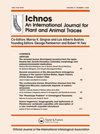印度小喜马拉雅Nigali Dhar向斜Koti Dhaman组沉积学、工艺学和层序地层学综合研究:古环境、古生态和古地理意义
IF 2
4区 地球科学
Q4 PALEONTOLOGY
Ichnos-An International Journal for Plant and Animal Traces
Pub Date : 2020-01-02
DOI:10.1080/10420940.2019.1584560
引用次数: 10
摘要
摘要介绍了小喜玛拉雅岩构造带Nigali Dhar向斜Tal群寒武系2期Koti Dhaman组下石英岩段至Arkosic砂岩段的综合技术、沉积学和层序地层学。与冈瓦纳虫亲缘关系密切的三叶虫(Cruziana salomonis、Cruziana fasciculata、Rusophycus dispar和Rusophycus burjensis)和砂粒石(Arenicolites isp)均有记录。和Skolithos isp。来自下石英岩段。在同一组的Arkosic砂岩段中,首次描述了丰富多样的Cruziana岩相组合。在Koti Dhaman组下石英岩至Arkosic砂岩段中发现了Cruziana- rusophycus、Planolites-Palaeophycus、Cruziana problematica、Diplichnites、Cochlichnus anguineus、Bergaueria perata和Psammichnites gigas 7个鱼化石组合。Koti Dhaman组发育砂岩-页岩相(FT1)、交错层状(槽状和平面)砂岩相(FT2)、层状砂岩相(FT3)、页岩相(FT4)、页岩-砂岩相(FT5)、页岩-波纹砂岩相(FT6)、平面-槽状交错层状砂岩相(FT7) 7种沉积相和FA1-FA4 4种沉积相组合。该地层包含浅层向上的潮滩复合体副层序。总的来说,确定了两个主要事件:1)下石英岩段与上覆页岩段之间的沉积断裂可能与强迫退退事件有关;2)Arkosic砂岩段从FT6到FT7的相转移代表了侵蚀海侵事件;该表面被解释为波浪冲刷面,也可作为层序边界。综合技术、沉积学和层序地层学研究表明,下石英岩段沉积于浅层潮下砂片杂岩和潮滩杂岩中;页岩段沉积在潮滩杂岩的泥滩环境中,Arkosic砂岩段沉积在潮滩杂岩-砂片杂岩前缘和边缘的混合滩(潮滩杂岩)中。总体而言,Koti Dhaman组下部至中部代表了潮滩复合体中以潮汐为主的浅层潮下潮间带至泥滩亚环境。根据小喜马拉雅和印度半岛(冈瓦纳东部)、埃及、约旦、土耳其(冈瓦纳西部)和加拿大(阿瓦洛尼亚)的Bikaner-Nagaur地区三叶虫痕迹的分布,提出了下寒武统(516-514 Ma)的古地理重建。本文章由计算机程序翻译,如有差异,请以英文原文为准。
Integrated sedimentological, ichnological and sequence stratigraphical studies of the Koti Dhaman Formation (Tal Group), Nigali Dhar Syncline, Lesser Himalaya, India: paleoenvironmental, paleoecological, paleogeographic significance
Abstract Integrated ichnology, sedimentology and sequence stratigraphy of the Lower Quartzite Member to the Arkosic Sandstone Member of the Koti Dhaman Formation (Cambrian Series 2, Stage 4), Tal Group, Nigali Dhar Syncline, Lesser Himalayan lithotectonic zone are presented. Trilobite traces of Gondwanan affinity i.e., Cruziana salomonis, Cruziana fasciculata, Rusophycus dispar and Rusophycus burjensis are recorded along with Arenicolites isp. and Skolithos isp. from the Lower Quartzite Member. A rich and diverse ichnoassemblage attributed to the Cruziana ichnofacies is described for the first time from the Arkosic Sandstone Member of the same formation. Seven ichnofossil assemblages, i.e., Cruziana-Rusophycus, Planolites-Palaeophycus, Cruziana problematica, Diplichnites, Cochlichnus anguineus, Bergaueria perata and Psammichnites gigas have been recognized in the Lower Quartzite to Arkosic Sandstone members of the Koti Dhaman Formation. Seven sedimentary facies i.e., sandstone–shale facies (FT1), cross-bedded (trough and planar) sandstone (FT2), bedded sandstone facies (FT3), shale facies (FT4), shale–sandstone facies (FT5), shale-rippled sandstone facies (FT6) and planar and trough cross-laminated sandstone (FT7) and four facies associations FA1-FA4 are identified in the Koti Dhaman Formation. The formation contains shallowing upward parasequences of a tidal flat complex. Overall, two major events are recognized: i) the break in sedimentation between the Lower Quartzite Member and the overlying Shale Member probably related to forced-regressive event and ii) the facies shift from FT6 to FT7 of the Arkosic Sandstone Member represents an erosive transgressive event; the surface is interpreted as wave ravinement surface, which also serves as a sequence boundary. Integrated ichnology, sedimentology and sequence stratigraphic studies indicate that the Lower Quartzite Member was deposited in a shallow subtidal sand sheet complex and tidal flat complex; the Shale Member was deposited in a mud flat setting of a tidal flat complex, and the Arkosic Sandstone Member in a mixed-flat (tidal flat complex) to sand sheet complex front and margin (subtidal sand sheet complex). Overall, the lower to middle part of the Koti Dhaman Formation represents a tide-dominated shallow subtidal–intertidal to mud-flat subenvironments of the tidal flat complex. A palaeogeographic reconstruction of lower Cambrian (516–514 Ma) is presented based on the distribution of trilobite traces from the Lesser Himalaya and the Bikaner–Nagaur area of Peninsular India (eastern Gondwana), Egypt, Jordan, Turkey (western Gondwana) and Canada (Avalonia).
求助全文
通过发布文献求助,成功后即可免费获取论文全文。
去求助
来源期刊
CiteScore
2.50
自引率
12.50%
发文量
0
审稿时长
>12 weeks
期刊介绍:
The foremost aim of Ichnos is to promote excellence in ichnologic research. Primary emphases center upon the ethologic and ecologic significance of tracemaking organisms; organism-substrate interrelationships; and the role of biogenic processes in environmental reconstruction, sediment dynamics, sequence or event stratigraphy, biogeochemistry, and sedimentary diagenesis. Each contribution rests upon a firm taxonomic foundation, although papers dealing solely with systematics and nomenclature may have less priority than those dealing with conceptual and interpretive aspects of ichnology. Contributions from biologists and geologists are equally welcome.
The format for Ichnos is designed to accommodate several types of manuscripts, including Research Articles (comprehensive articles dealing with original, fundamental research in ichnology), and Short Communications (short, succinct papers treating certain aspects of the history of ichnology, book reviews, news and notes, or invited comments dealing with current or contentious issues). The large page size and two-column format lend flexibility to the design of tables and illustrations. Thorough but timely reviews and rapid publication of manuscripts are integral parts of the process.

 求助内容:
求助内容: 应助结果提醒方式:
应助结果提醒方式:


